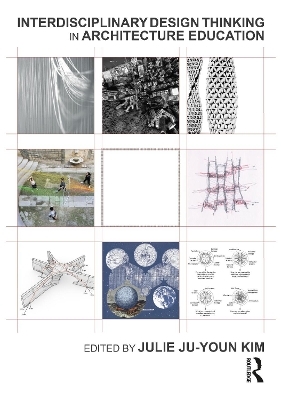
Interdisciplinary Design Thinking in Architecture Education
Routledge (Verlag)
978-1-032-28337-1 (ISBN)
- Titel z.Zt. nicht lieferbar
- Versandkostenfrei innerhalb Deutschlands
- Auch auf Rechnung
- Verfügbarkeit in der Filiale vor Ort prüfen
- Artikel merken
Annotated case studies, both from academic institutions and from professional practices, provide examples of interdisciplinary engagement in creative design work, highlighting the challenges and opportunities of this approach. Cases are from a diverse selection of international collaborators, featuring projects from the United States, Australia, Mexico, Germany, and Italy, and cover a range of project types and scales. Chapters by invited experts offer speculations on current and future models, situating examples within the broader context, and encouraging dialogue between practice and pedagogy. The collection of voices in this book offers critical and provocative lenses, learning from history while forging inventive and creative roles for the architect as practitioner, entrepreneur, strategist, choreographer, activist, facilitator, leader, and teacher.
Interdisciplinary Design Thinking provides insights into the potential of interdisciplinary engagement at the level of foundational undergraduate education, making it ideal for faculty in architecture schools. It will also be of interest to design professionals concerned with interdisciplinary collaboration and how to incorporate similar efforts in their own practices.
Julie Ju-Youn Kim, AIA is an associate professor at Georgia Institute of Technology’s School of Architecture, where she founded and currently directs the Flourishing Communities Collaborative, an interdisciplinary research and design lab. Incorporating goals of equity and inclusion in scholarship and design pedagogy, Julie received the 2023 AIA Georgia Educator of the Year and the 2023 ACSA Collaborative Practice Award, for connecting the academy and architectural practice by creating replicable models of engagement to expand equity through access. With support from the New Venture Fund/Public Interest Technology-University Network and Partnership for Inclusive Innovation, Julie’s teaching and research leverages data-driven and quantitative methodologies to solving social and cultural problems in the built environment. Julie is a licensed architect whose publications link her leadership and teaching in pursuit of interdisciplinarity in architecture education, research, and practice. She holds a M. Arch from the Massachusetts Institute of Technology and BA from Wellesley College.
1. Setting the Table PART 1: Expanding Disciplinary Fields: Speculations across Past, Current, and Future Models in the Academy 2. Re-thinking Architecture Education 3. Questioning "Best" Practices in Architectural Education 4. From Disciplinary Fields to Interdisciplinary Challenges: Shifting the Focus of Architectural Education 5. Integrative Technologies in Architecture: Towards an Interdisciplinary and Future-Proof Research Culture 6. Which comes first? 7. Interdisciplinary Transition 8. The Yamuna River Project: Interdisciplinarity across and beyond the field of the built environment in architectural education 9. Building Innovation at Arizona State University 10. Data augmented design intelligence: Enabling Interdisciplinarity 11. Out of Scope: How Megaliths Challenge Architecture’s Role 12. Perform: Making a case for expanded Structural Dialogues in Architecture Education 13. Aqueous Landscapes: Teaching and learning in the intertidal zone in second year architectural design studio 14. Building Beloved Community through the University of Washington’s Nehemiah Interdisciplinary Studio 15. Integrated Studio: Trade-offs as a Mechanism for Collaboration 16. The story of a semi-scientist PART 2: Integrating Disciplines: Speculations across Past, Current, and Future Models in Practice 17. Learning from Practice – or Practice Learning from Education 18. Meandering Transdisciplinary Lands 19. Crosscoding Cultures: Design and Data Across Disciplines 20. Incongruities in Contemporary Architecture 21. Practice beyond the Digital Bubble 22. The Unexpected Solution: How Multidisciplinary Enriches the Design Process 23. Learning by Doing 24. Pedagogical Practices PART 3: Experimenting in Interdisciplinarity: Speculations across Past, Current, and Future Models in the Academy and Practice 25. Shameless Experimentation: Making space for interdisciplinary exchange 26. Expanding Interdisciplinary Fields: Reflections on the Science of Design 27. Interdisciplinary Dialogues: What are the Boundaries of Design (or Design as a mode of inquiry) 28. Walking the Boundaries of the Built Environment
Alan Organschi
| Erscheinungsdatum | 12.12.2023 |
|---|---|
| Zusatzinfo | 3 Line drawings, black and white; 138 Halftones, black and white; 141 Illustrations, black and white |
| Verlagsort | London |
| Sprache | englisch |
| Maße | 174 x 246 mm |
| Gewicht | 720 g |
| Themenwelt | Kunst / Musik / Theater ► Design / Innenarchitektur / Mode |
| Naturwissenschaften ► Biologie ► Ökologie / Naturschutz | |
| Sozialwissenschaften ► Pädagogik ► Erwachsenenbildung | |
| Technik ► Architektur | |
| ISBN-10 | 1-032-28337-8 / 1032283378 |
| ISBN-13 | 978-1-032-28337-1 / 9781032283371 |
| Zustand | Neuware |
| Haben Sie eine Frage zum Produkt? |
aus dem Bereich


